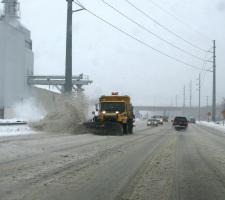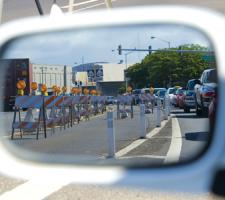
Imran Hayee of the University of Minnesota Duluth's Department of Electrical and Computer Engineering talks about efforts to bring V2I and V2V communications into work zones
With USDOT backing and under the auspices of the ITS Joint Program Office Connected Vehicle Research (formerly IntelliDrive) research programme, M. Imran Hayee of theFunding for NATSRL comes from various sources including the ITS Institute, University of Minnesota Twin Cities.
The main thrust of the work was to see how V2I and V2V technologies could be used to communicate travel times and the point of the start of congestion (that is, where free-flowing traffic starts to break down) to road users, allowing them to make informed choices as to whether to continue on through the work zone area or take an alternative route.
To explore this, a single 5.9GHz DSRC RoadSide Unit (RSU) was set up in a simulated work zone and used to communicate with two other vehicles equipped with DSRC OnBoard Units (OBUs). Hayee and his students were able to prove, after testing in both urban and rural environments, that the use of V2I and V2V technologies improves both information gathering and dissemination in a work zone environment.
Gathering data
To determine travel times and locate the start of congestion, data from GPS receivers in vehicles' OBUs is processed. Each OBU responds to queries from the RSU as it comes into range before encountering congestion. This GPS location data allows for a significant error range. To account for this a preliminary error-correction operation takes place within the OBU; this ensures that the vehicle is travelling toward the RSU and is within the area where data on vehicle movement will be useful for calculating travel time and locating the start of congestion.
The RSU then carries out a fine location check. This second, more precise check rules out the possibility that the approaching vehicle is travelling on a nearby, parallel road which is within the error margin of the preliminary check. Only vehicles which pass the fine position check are recognised as sources of speed and congestion data for the RSU. The OBU then starts to transmit messages containing time, speed and location data to the RSU at one-second intervals until it reaches the point where congestion ends. As soon as an OBU passes beyond the end of congestion point, the RSU processes the data it has received, updates the start of congestion and travel time locations, and prepares to contact the next OBU to arrive in its coverage area.
Establishing two-way communications
"Work zone safety is but one application. However it's worth considering the 'bigger picture' and the recent history of V2I and V2V development in the US when considering how and when we might see such systems deployed in the work zone, and also to gain a better appreciation of the effects on the form of the field demonstration," says Hayee.
"The 1999 allocation of spectrum at 5.9GHz for vehicle- and road-related safety applications led to an explosion of interest and activity within the research community but it hasn't yet filtered out into the real world. The main hurdle has been capital cost. The initial emphasis of what was Vehicle-Infrastructure Integration, or VII, was more on V2I than V2V. It envisaged the establishment of a network of DSRC RSUs at every mile along every road in the US. It took some time for the realisation to filter through of just how cost-prohibitive such an approach would be. The programme has evolved and the emphasis has shifted, therefore, with more weighting towards V2V but still supported by V2I. In-vehicle installation of OBUs is much easier to achieve and with the OEMs' agreement could be achieved at a cost of around $100-200 per vehicle. Once we have that, we have an information infrastructure which will allow both acquisition and dissemination.
"Current work zone ITS solutions use decades-old technology, typically loop detectors and information provision via Variable Message Signs [
"In terms of time to market and turning this into a viable real-world solution, the ideal is always going to be 100 per cent penetration of the vehicle fleet with DSRC OBU technology. This application would work well with a penetration of around 20-25 per cent, however. The short-range, line-of-sight nature of DSRC is the main problem when using V2I. Using V2V we can propagate messages over, potentially, tens of kilometres and cover congestion lengths of up to a few kilometres. That's something for the future which needs more work but another option might be to use cellular technology; that's not using dedicated spectrum in the way that DSRC is but the work zone application doesn't need the extremely low latency which is required, for example, for intersection safety applications.
"One of the big public concerns is security and privacy but, in fact, it just isn't an issue - the wireless technology used is secure. Within the work zone application, we generate a random ID for each vehicle. That means that there was no direct way of connecting information on a vehicle's movements with its actual identity. And nothing is permanently stored as there's simply no need for that. What we've come up with is a definite leap forward for work zones."
Advancing the art
Looking forward, Hayee says that there are many potential ways to expand upon the work he and his colleagues have already done. In 2013, the US's
User interface
The use of a consumer smartphone as the driver interface is an innovative aspect of the prototype system, and one that allows significant cost savings. Instead of having a dedicated driver interface, each OBU is equipped with a communication interface device that connects to a smartphone via Bluetooth. An application installed on the smartphone connects automatically to the OBU and presents information to the driver in the form of text messages. Going forward, the system architecture designed by Hayee and his team could support different user interfaces, such as integrated dashboard displays or other types of onboard navigation devices. In fact, additional improvements are already planned for the driver interface unit, including augmenting the information presented to the driver with graphics and maps, and ultimately developing a text-to-voice system.
"The NHTSA 2013 decision is an important one and we expect to see good OBU penetration from around 2020. Automotive manufacturers will certainly be encouraged to accelerate fitment if we can demonstrate good applications which improve road safety and operations and also benefit the user.
"We'll be taking the snowplough application forward next year. We've also been looking at a merge-assist application which can be used ahead of work zones to smooth traffic flow. Merge-assist is very much V2V and DSRC-only. That work remains at the proposal stage but it's a direct safety issue which can definitely be solved with the technology at hand."













